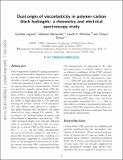Dual Origin of Viscoelasticity in Polymer-Carbon Black Hydrogels: A Rheometry and Electrical Spectroscopy Study
Author(s)
Legrand, Gauthier; Manneville, Sébastien; McKinley, Gareth H.; Divoux, Thibaut
Download2210.03606.pdf (2.875Mb)
Open Access Policy
Open Access Policy
Creative Commons Attribution-Noncommercial-Share Alike
Terms of use
Metadata
Show full item recordAbstract
Nano-composites formed by mixing nanoparticles and polymers offer a limitless creative space for the design of functional advanced materials with a broad range of applications in materials and biological sciences. Here we focus on aqueous dispersions of hydrophobic colloidal soot particles, namely carbon black (CB) dispersed with a sodium salt of carboxymethylcellulose (CMC), a food additive known as cellulose gum that bears hydrophobic groups, which are liable to bind physically to CB particles. Varying the relative content of CB nanoparticles and cellulose gum allows us to explore a rich phase diagram that includes a gel phase observed for large enough CB content. We investigate this hydrogel using rheometry and electrochemical impedance spectroscopy. CB-CMC hydrogels display two radically different types of mechanical behaviors that are separated by a critical CMC-to-CB mass ratio ��. For �<��, i.e., for low CMC concentration, the gel is electrically conductive and shows a glassy-like viscoelastic spectrum, pointing to a microstructure composed of a percolated network of CB nanoparticles decorated by CMC. In contrast, gels with CMC concentration larger than �� are non-conductive, indicating that the CB nanoparticles are dispersed in the cellulose gum matrix as isolated clusters, and act as physical crosslinkers of the CMC network, hence providing mechanical rigidity to the composite. Moreover, in the concentration range, �>�� CB-CMC gels display a power-law viscoelastic spectrum that depends strongly on the CMC concentration. These relaxation spectra can be rescaled onto a master curve that exhibits a power-law scaling in the high-frequency limit, with an exponent that follows Zimm theory, showing that CMC plays a key role in the gel viscoelastic properties for �>��. Our results offer an extensive experimental characterization of CB-CMC dispersions that will be useful for designing soft nano-composites based on hydrophobic interactions.
Date issued
2023-03-14Department
Massachusetts Institute of Technology. Department of Mechanical Engineering; Hatsopoulos Microfluids Laboratory (Massachusetts Institute of Technology)Journal
Macromolecules
Publisher
American Chemical Society (ACS)
Citation
Legrand, Gauthier, Manneville, Sébastien, McKinley, Gareth H. and Divoux, Thibaut. 2023. "Dual Origin of Viscoelasticity in Polymer-Carbon Black Hydrogels: A Rheometry and Electrical Spectroscopy Study." Macromolecules, 56 (6).
Version: Author's final manuscript
ISSN
0024-9297
1520-5835
Keywords
Materials Chemistry, Inorganic Chemistry, Polymers and Plastics, Organic Chemistry